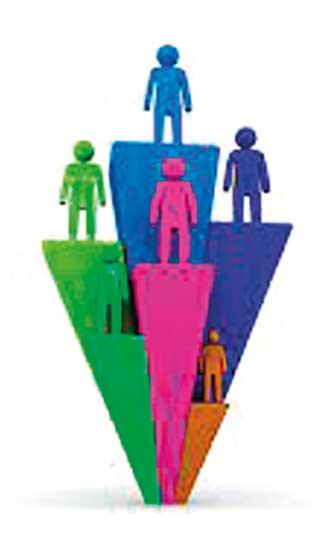08 Nov 2021 - {{hitsCtrl.values.hits}}
 “Sri Lankan children make a dangerous climb for online school,” read the headline of a recent article carried by Al Jazeera.
“Sri Lankan children make a dangerous climb for online school,” read the headline of a recent article carried by Al Jazeera.
The article and many others like it, came out in response to a set of photographs making the rounds on social media. The images showed children in remote areas of Sri Lanka, perched precariously on branches and climbing massive boulders to reach the highest points of their villages for better internet connectivity – perfectly capturing the struggles faced by some children in accessing online education during the pandemic.
 Around the same time another set of photographs also went viral but for very different reasons. They featured Sri Lankan public health workers trekking through the same lush green forests and rocky hillsides, carrying lifesaving COVID-19 vaccines to people in hard-to-reach areas.
Around the same time another set of photographs also went viral but for very different reasons. They featured Sri Lankan public health workers trekking through the same lush green forests and rocky hillsides, carrying lifesaving COVID-19 vaccines to people in hard-to-reach areas.
These real-world pandemic responses speak volumes about the power of human capital. They are stories of commitment, resilience and perseverance that confirm beyond doubt that Sri Lanka’s greatest asset is its people.
In Sri Lanka, as in many other countries, the pandemic highlighted important structural challenges. For instance, it exposed the limited robustness and preparedness of service delivery systems. Yet, the pandemic has also offered a unique opportunity to reassess, repair and realign.
At this crucial juncture, it is important to consider how human capital factors into the equation. Human capital consists of the knowledge, skills and health that people accumulate over their lives. Investing in human capital means investing in services that keep people healthy, provide access to quality education and deliver social support for families and individuals at different stages of their lives. It also means building systems that enable early intervention and support to vulnerable populations in times of crisis.
Sri Lanka’s investments in public healthcare have yielded incredible results. On top of good healthcare indicators and the successful eradication of Polio and Malaria, Sri Lanka has now vaccinated 89 percent of its population over 20 years against COVID-19. Surprisingly, Sri Lanka’s public investment in health is only 1.5 percent of GDP, lower than the South Asian average.
It is commendable that the country has achieved and sustained high standards with minimal investment but the system will soon be faced with new challenges. The population is aging and by 2035, one in four Sri Lankans will be over the age of 60. Non-communicable diseases such as diabetes and heart conditions are fast becoming the leading causes of morbidity and mortality in the country. The healthcare system needs further investment to adapt and remain responsive to changing needs and priorities.
Population ageing will also impact the family unit. As family structures and traditional social support systems change, Sri Lankan families and especially women, will need more support outside the home. Despite high educational attainment among women, the female labour force participation rate in Sri Lanka was just 32 percent in 2020, compared to a rate of 72 percent for men. As the population ages, women may have to bear the brunt of both child and elderly care. Childcare support and social welfare services will require significant restructuring to ease the burden on families.
Progressive changes are also needed in education. Inequalities in education extend beyond online platforms and the connectivity issues faced by rural children are merely symptoms of a broader issue. Despite near universal enrolment rates for primary and secondary education, major disparities exist in the quality of education and consequently in the learning outcomes among children from varying income levels and geographical areas.
Human Capital Report 2020 noted that though the expected years of schooling in Sri Lanka was 13.2 years, the learning adjusted years of schooling was only 8.5 years. This is a learning loss of 4.7 years, the highest in South Asia. It is safe to assume that these losses will be exacerbated by the extended school closures caused by the pandemic.
Sri Lanka’s public spending on education (1.7 percent of GDP) is also lower than the South Asian average and the country can benefit from increased investments at all levels of education. Increasing access to early childhood education, improving the quality of primary and secondary schooling and reorienting higher education can help reverse learning losses and improve educational outcomes.
Beyond formal education, investments in vocational education and training can increase employability and promote alternate opportunities. The many local start-ups, home businesses and online services that have emerged over the past two years are a testament to Sri Lanka’s ingenuity and creative potential. Fostering self-employment and entrepreneurship will open new doors to Sri Lankan change makers. This includes the provision of comprehensive and targeted livelihoods support for the poorest and most vulnerable Sri Lankans through the Samurdhi programme.
Forward thinking, focused and inclusive investments in human capital are sorely needed to support the path to recovery. If Sri Lanka can have one take away from the pandemic, it should be this - invest in people, especially in those who must hike up rocks or trek across rivers to better themselves and to help others.
They are clearly worth the investment.
(Hartwig Schafer is Vice President, South Asia Region, the
World Bank)
23 Dec 2024 3 hours ago
23 Dec 2024 5 hours ago
23 Dec 2024 5 hours ago
23 Dec 2024 5 hours ago
23 Dec 2024 7 hours ago